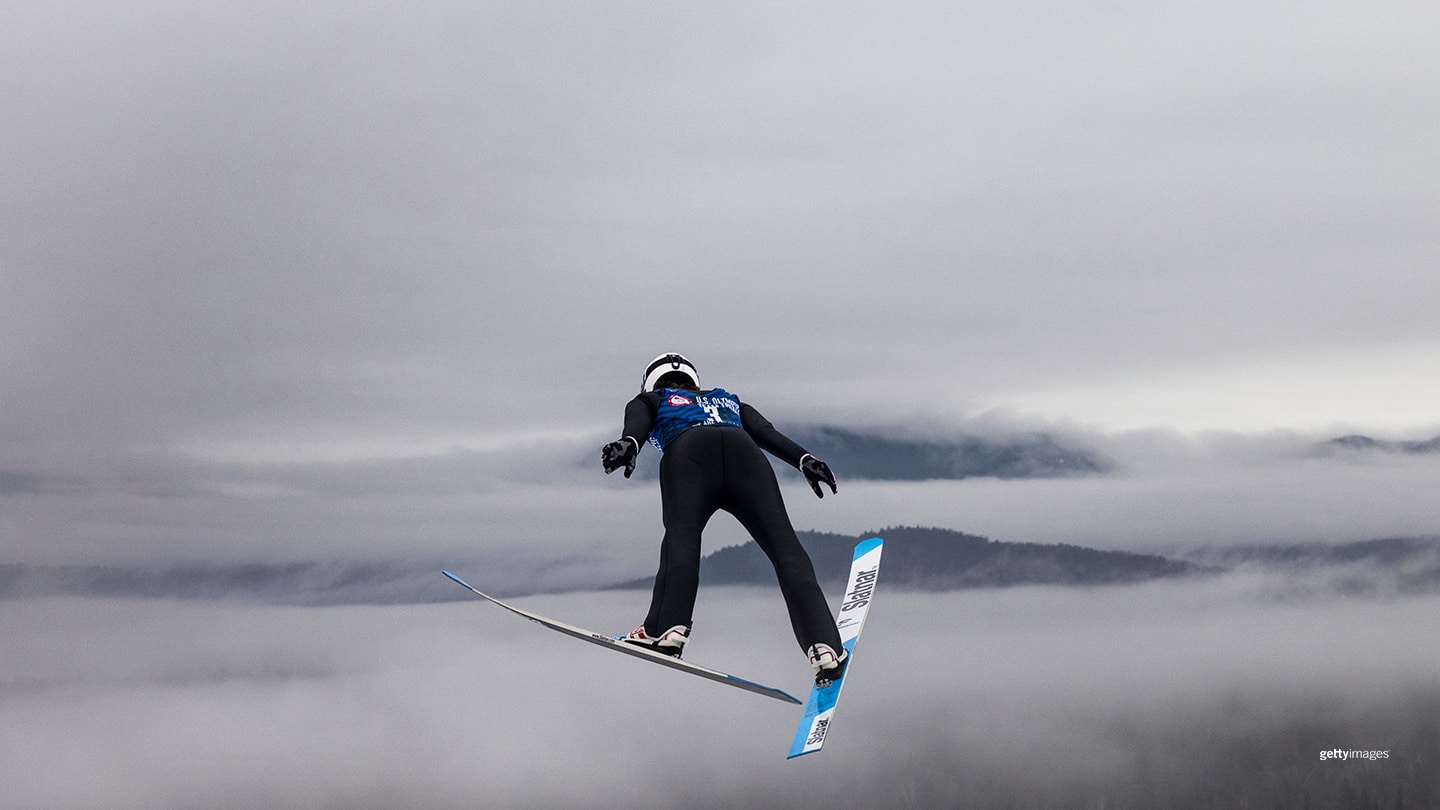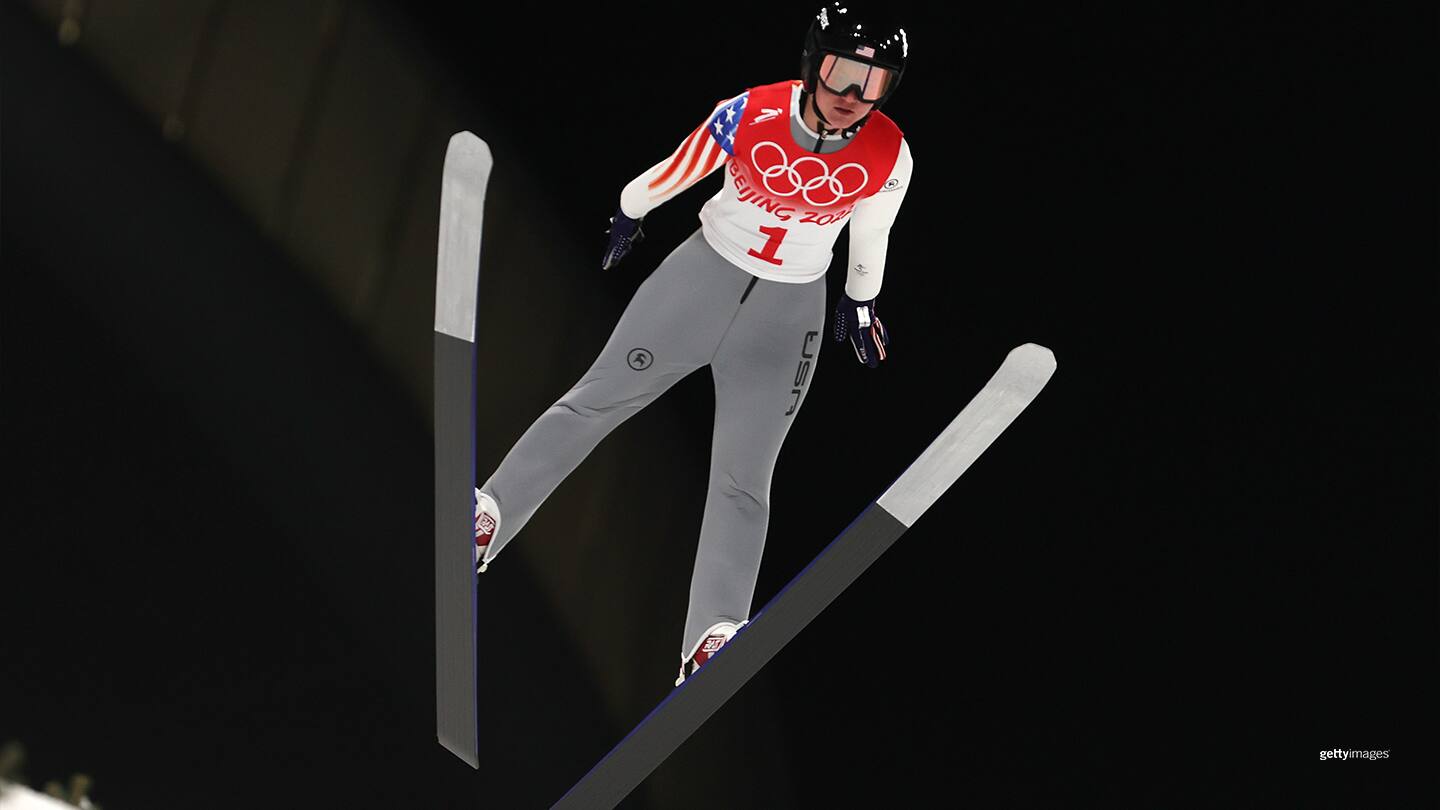
A New Approach, And Partnership With Norway, Bring New Possibilities For U.S. Ski Jumping
by Nicole Haase

Erik Belshaw jumps during the U.S. Nordic Combined & Ski Jump Olympic Trials on Dec. 25, 2021 in Lake Placid, N.Y.
The post-Olympic season is the best time to reset, reevaluate and make changes, said USA Nordic Sport ski jumping coach Anders Johnson, and now a groundbreaking partnership and new program philosophies could make this one of the most interesting U.S. ski jumping seasons in recent memory.
“We have a group of young, really motivated and talented athletes,” he said. “So the timing was perfect for us to really shift gears.”
Announced in August, the partnership between USANS and the Norwegian ski jumping federation is a manifestation of Norway’s desire to ensure the future of the sport at an elevated level. The Norwegians want ski jumping to be a global sport, not just one dominated by European countries, and they also want to be the most influential nation in ski jumping, said Johnson.
While the joint training camps and coach’s clinics have already made a big impact, the collaboration is just one step Johnson and his team have taken to reshape the future of U.S. ski jumping. A lack of consistent results and athlete retention were just some of the reasons Johnson, himself a three-time U.S. Olympian, said that USANS had to take a hard look at what they were doing and rethink the approach.
“We’d been operating the same way for close to a decade and we really haven’t yielded the results that we want,” he said.
A big focus has been on utilizing training locations in the U.S. In past years, the teams had been based in Slovenia for up to 11 months out of the year. In a mentally taxing sport, being away from home that long is just one more stressor. It has led to early burnout and is one of the challenges USANS must overcome when trying to recruit athletes into the sport.
“We want the athletes to be able to spend as much time back in the U.S. as possible and be a little bit more creative with our time spent in Europe,” Johnson said.
This change in approach aims to benefit the current national team athletes while also helping with recruiting future ones by showing that there is a pathway to becoming a world-class athlete that does not require them to leave home as a teenager and relocate to another country.
An important change this year for the women is that it will be the first season that women are allowed to participate in ski flying, which Johnson described as the pinnacle of the sport, more or less. Ski fliers use a hill twice the size of the largest hill at the Olympics and can fly a distance more than 200 meters – or more than two football fields in length.
“It shows the growth that women’s ski jumping has seen over the past decade,” Johnson said. “To finally be allowed to go ski flying is a huge step in bridging the inequality gap that exists in sports in general, but for sure in ski jumping.”

Anna Hoffmann jumps during the women's normal hill individual first round at the Olympic Winter Games Beijing 2022 on Feb. 5, 2022 in Zhangjiakou, China.
Another shift has the men’s and women’s teams spending more time together as one squad. Their season schedules don’t always line up. But, when possible, they’ll be training and learning in one group.
“If we can get all of our strongest athletes — male and female — together, we believe they’re going to build a better-quality national team,” Johnson said.
Both men’s and women’s teams are young. The ages on the men’s team range from 18 to 23. On the women’s side, the youngest member, Josie Johnson, just turned 16, while the oldest is 22-year-old Anna Hoffmann. Hoffmann was Team USA’s lone female participant in the Olympic Winter Games Beijing 2022.
That makes them adaptable to the many ways USANS has changed its approach to ski jumping in the past year. But it also means that coaches are taking a very pragmatic approach to the upcoming season. Younger ski jumpers will compete in development-level and junior events to gain confidence. The goal is to improve the U.S.’ overall international rankings and turn out sustained, consistent results.
“We’re still really focused on this new athletic and technical approach that we’re taking,” Johnson said. “We understand that it’s going to take time. It’s not immediate. However, it’s not inconceivable to think that we can take a big step internationally and start getting some higher-level results. Realistically what we’re looking at is building our base and finding more consistency with our athletes. It’s still a really young team but is a healthy mix of veterans and juniors together pushing each other.”
Eighteen-year-old Erik Belshaw and Josie Johnson will both compete at the junior level, where Johnson said both have the potential of making the podium at the junior world championships. The event takes place in Whistler, British Columbia this year.
That’s usually about as close to home as U.S. ski jumpers can hope for. However, the world cup circuit is returning to the United States for the first time in 19 years. The men’s event will take place Feb. 10-12, 2023, in Lake Placid, New York.
“The new partnership with Norway is really about growing the sport of ski jumping in the United States,” Johnson said. “That starts with having high-level international events in the U.S. To be able to bring the highest level of the sport to our backdoor, basically is huge for us.”
While it isn’t close to home, the world championships for men and women this season will be held in Slovenia, USANS’ old training base. That familiarity should give them extra confidence at the biggest event of the season, Johnson said.
Nicole Haase is a freelancer for TeamUSA.org on behalf of Red Line Editorial, Inc.